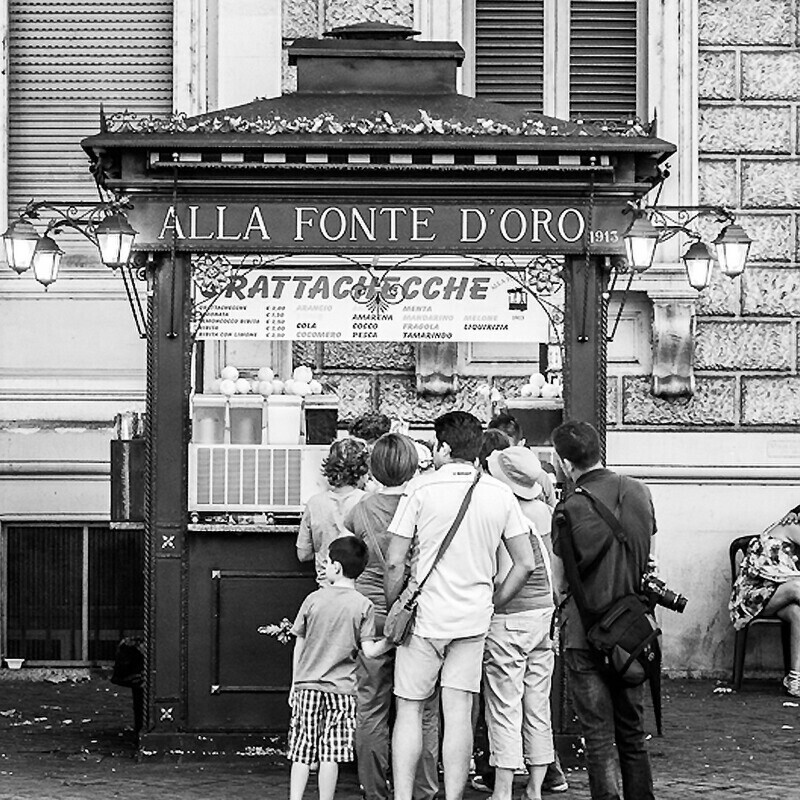
From ice-houses to Kelvinator, progress has run its course culminating in a range of opportunities for creative people endowed with extraordinary culinary flair, personalities that today we call Master Craftsmen.
Behind every great gelato lies the abundance of Italian agricultural heritage fueled by producers who, from North to South, take care of the land that shapes one of the most beautiful countries in the world.
Gelato, whose name overcomes every universal language barrier, finds the roots of its modern connotation in Medicean Florence, wherein the 16th century the Florentine confectioners of Caterina de' Medici invented this tasty recipe made with milk, cream and eggs; today gelato is one of Italy's most exported Italian products ever.

Italy confirms its position as the world leader in the production of gelato appliances and displays, as well as in the market of ingredients and semi-finished products: with more than 39 thousand gelato parlors throughout the country, Italy is also first in terms of turnover with 30% of the European market and 60% of the world's sales.
From March to October, gelato parlours all over Italy - and the world - are crowded with gourmands looking for a sweet and fresh treat to indulge in at any time of day. When in Sicily, for example, the most popular dessert of the peninsula is consumed starting from breakfast.

The culinary itinerary begins in 1806 in Piedmont
This is where hazelnuts are cultivated and, in 1993, were awarded PGI (Protected Geographical Indication) recognition. Hazelnut gelato also seems to be the most popular flavour in Italy.
Piedmont's classic hazelnut gelato is rivalled only by Gianduia, which boasts cocoa notes due to the chocolate and hazelnut mixture created in Turin in 1806.

Lombardy's culinary avant-garde: gelato in Milan is a synonym of innovation.
A well-known Milanese ice-cream parlour has decided to experiment by winking at typical local products to give its Milanese 7 flavours dedicated to Lombardy inspired by tradition and the excellences of the house. Thus was born the Ris e Lat (rice and milk) gelato, or the Charlotte à La Milanesa flavour, the Milanese cake made with bread and apples.
On the other hand, the most traditionalist palates will find nougat ice cream par excellence in Cremona.

In Veneto, Sbatudin gelato is "restorative"
This is how the brand new artisan gelato flavour created by the Veneto Gelato Association is defined.
Invented to promote the relaunch of the regional economy due to the health emergency, Sbatudin, which takes its name from the egg and sugar-based restorative, is enriched by a wine product such as Passito.

In the Capital, summer is endured thanks to Grattachecca
Considered to be the queen of Capitoline street food, Grattachecca is a frozen slush covered with syrup flavoured with tamarind, lemon, black cherry or mint. It is best enjoyed while strolling along Trastevere at any hour of the day.

The Pizzo Truffle is to Calabria as the Carapigna is to Sardinia
Two regions, two culinary personalities as different as they are unique, interpreted in an artisanal way; in Calabria, Tartufo di Pizzo Calabro is the first gelato that received the PGI certification in Europe.
On the other hand, Sardinia is distinguished by the taste of authenticity of Carapigna, a delicate and refreshing sorbet made with water, sugar and lemon. Still made according to Sardinian tradition, Carapigna is the Island’s oldest ice cream.
The itinerary ends in the homeland of gluttons, Sicily
In Sicily, gelato is the art of combining tradition with the land’s genuine flavours: here, locals start enjoying ice cream right from breakfast with a “brioche col tuppo”, the classic Sicilian Brioscia, accompanied by an almond slush, the same brioche that will be filled with Bronte Green Pistachio gelato, a PDO variety and a Slow Food Presidium.

For all these Italian artisanal excellence, Mondial Framec, with its Mirabella and Dolce Vita displays branded Framec, is a valid commercial ally for maintaining and displaying slush Grattachecche or scoop gelato, sticks and frozen pastries.
In short, gelato in Italy leaves no one high and dry. From North to South, hopping by the Islands, each Region has its flavours and traditions: Mondial Framec will continue providing the professional tools necessary to continue writing the history of Italian gelato.